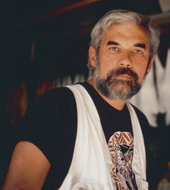
Click an Image below to Enlarge

Contemporary Australian artist Lin Onus was born in 1948 in Melbourne. His father, Bill, was a political activist and businessman who became the founder of the Aboriginal Advancement League and the first Aboriginal JP.
Surrounded by classical art and music in a home built by his maternal grandfather, Onus developed an early passion for art. He was a largely self-taught urban artist who began as a motor mechanic before making artifacts for the tourist market in his father's business. Discovering a set of student paints left at the workshop of his father's Aboriginal Enterprises business in the Dandenong Ranges on the outskirts of Melbourne was the impetus for Onus to create his first painting. The sale of this painting for $22 at the Sherbrooke Art Society Fair further fuelled his passion for painting.
The attitude and work of Lin Onus stemmed heavily from his background. Born of an Aboriginal father and a Scottish mother, Onus endeavoured to discover his own identity by mixing the indigenous and Western styles in his own unique way. With his father being of the Yorta Yorta people from the Barmah Forest country, Onus used images from this area when he began painting and sculpture in 1974.
During his training as a young mechanic Onus became fascinated with spray painting and fibreglass moulding, later modifying and incorporating these techniques into his works. He was heavily influenced both artistically and emotionally by his frequent visits to Arnhem Land. During this time he formed a unique friendship with artist and elder Jack Wunuwun who became his mentor. This friendship not only strengthened his links with his Aboriginal heritage but also earned him the right to incorporate "rrark", a traditional cross hatching design, particular to the Arnhem region, into his work.
Onus created paintings that were not only essentially Australian but also portrayed what it means to be an Aboriginal Australian living in a city. He was instrumental in raising the profile of indigenous art and is considered to be one of the leaders of the urban Aboriginal Art Movement. Onus’ work is widely appreciated for his technical skill as much as the mix of styles. His strong socio-political views combined with great artistic expertise resulted in art that is political, provocative and distinct.
In the late 1980s the concept of reconciliation took centre stage on Australia's political and legal arena. The right of all people to pursue their lifestyles and culture in accordance to their own traditions was a vision shared by many Australians and became the central motivating force behind the work of Lin Onus. For most of his artistic life, Lin Onus used diverse and uniquely Australian images in his multi layered and humorous works to express his commitment to bridging the gap between urban and traditional, indigenous and white Australia.
Onus utilised a diverse range of mediums, methods and styles in his work and was often quoted as saying that he belonged to the "Bowerbird" school of arts by adopting bits from everywhere. He used painting, printmaking, linocuts, comic illustration, murals, poster design and political sculptures. Motif and metaphor are dominant features of Onus's work. Onus participated in 80 Australian and international exhibitions and his works are represented in over 50 major public, private and corporate collections.
Acknowledged as one of Australia’s most prominent contemporary painters, Lin Onus was the recipient of many awards and appointments of note, including the 'Introduced media section' in the Fifth National Aboriginal Art Award, Darwin, 1988 and the Kate Challis RAKA (Ruth Adeney Koori Award), Melbourne, 1993. In the same year he was made a member of the Order of Australia on the Queen's Birthday Honours List. His painting Barmah Forest won Canberra's National Indigenous Heritage Award in 1994 as well as the People's Choice Award. Appointed a member of the Aboriginal Arts Board of the Australia Council in 1986, Onus became Chairman of the Board from 1989 to 1992, was co-founder of the Aboriginal Arts Management Association in 1990 and a founding member and Director of Viscopy in 1995.
Whilst the artist’s early works displayed anger at Aboriginal social injustice, he later used whimsy to paint a less harsh picture.
Perhaps he learned the power of humour from his father, Bill who, in his role as President of the Australian Aborigines League, was asked to provide a suitable token Aboriginal name for a new Melbourne community festival. Lin relished recounting how his father suggested “Moomba” to the gullible city fathers, saying it meant “let's get together and have fun”.
Moomba remained the name of the festival for 50 years, despite its real Aboriginal meaning being “bum …”
Onus died prematurely aged 48 and was buried at the settlement of Cummeraguna on the NSW-Victorian border.
"I kind of hope that history may see me as some sort of bridge between cultures, between technology and ideas." Lin Onus, artist statement, 1990.
Copyright © 2007 Abstract Australis. All rights reserved. Click here to view copyright statement